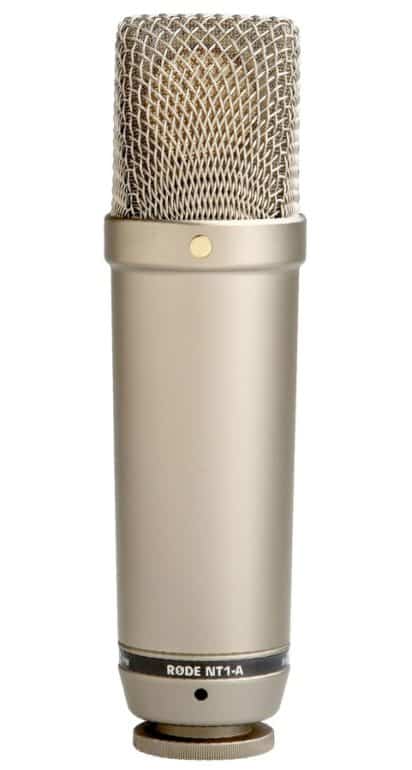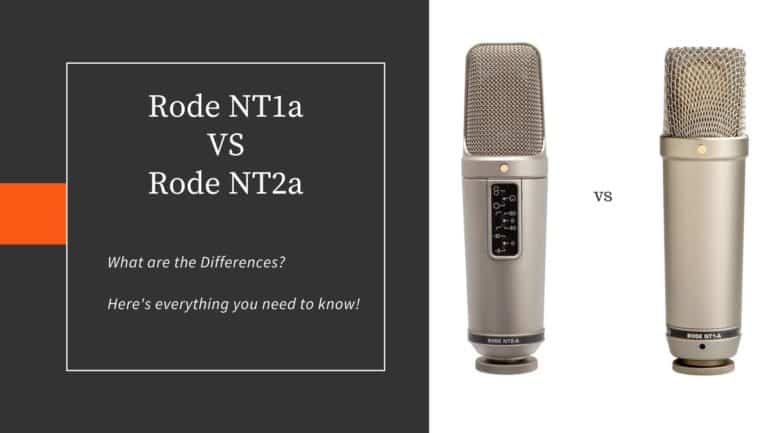Last updated on December 30th, 2023 at 02:49 pm
Have you ever wondered what the differences between the Rode NT1a and the NT2a are?
Both of these microphones are a staple in todays recording industry and you can find them in almost any music studio.
In this post I’ll give you an overview of both microphones as well as tell you their differences, and lastly which one I think you should choose.
Let’s get straight into it…
Rode NT1a

The Rode NT1a is one of the most famous and used microphones in the recording industry.
Some people praise it as if it were the best microphone to be ever created and they even compare it to other ones that are in a much higher price range.
The reason why the Rode NT1a is so good is because it will give you a very accurate representation of what is being recorded, meaning that it should easily fit within any mix.
It has a very natural sound, even though after reading some reviews online I found that people complained about it having a bit of a harshness, or high frequency/presence boost, which is actually quite common on microphones at this price range.
However, this all depends on your specific taste, since every microphone will have its own character.
Some people might find that it enhances their voice, while others may find that it makes their voice sound horrible and shrill.
Now, as far as the build quality goes, I honestly can’t complain at all!
It’s absolutely fantastic and it’s built to last.
Sadly, the Rode NT1a doesn’t come with a PAD or High–Pass filter, it’s just the bare microphone, but it is a great performer and it does what it’s supposed to do.
It has a slight boost at around 150Hz and the 6k to 12kHz range, with a deep cut at the high-end; all this means that it will be actually quite bright sounding, which is what I referred to earlier by saying that people found it to be a bit harsh at times.
How does it Perform?
I found it great for recording vocals, acoustic guitar and electric guitar, but to be honest… once you get to this level of microphones it gets hard to really find one that doesn’t really do what it’s supposed to.
It all comes down to your own preferences, what kind of tone you’re going for, etc.
I actually do like the high-end boost a bit since it gives it a more “airy” sound, which I always liked.
This is also something that works well with acoustic guitars, since that high-end boost really opens up the higher frequencies, making the guitar sound better.
As I mentioned earlier, it all depends on your personal taste.
If you want a microphone which has an identical build quality but which sounds a bit darker, then check out the Rode NT1.
You can find that one in my post about the best microphones under $300.
Pros
- The build quality is fantastic.
- The shock mount is metal, when most included ones are made of plastic.
- It’s insanely quiet (Low self-noise).
- Open and Airy high-end.
- Can Handle high SPL.
Cons
- The presence boost could make your recordings too bright potentially. It can also you make your vocals a bit more sibilant.
- The included cable isn’t the best one.
What comes in the Box?
- The Rode NT1a microphone.
- A Storage Pouch.
- You also get the shock mount which comes with a pop filter already attached.
- And lastly you get an XLR cable.
Specifications
- Polar Pattern: Cardioid
- Frequency Response: 20Hz – 20kHz
- SPL: max 137dB
- Impedance: 100 Ohms
- Sensitivity: -32dB
- Self Noise: 5dB
Find out more about the Rode NT1a here:
- Rode NT1a: Amazon, Sweetwater.
Rode NT2a

Right off the bat you might have noticed the price difference between the NT1a and the NT2a; The NT2a is twice as expensive or even more.
The reason for this is not necessarily an improvement in audio quality, but rather in versatility.
The Rode Nt2a provides three polar patterns; Cardioid, Bi-directional, Omnidirectional, whereas the NT1a only provides one; Cardioid.
What this means is that even though the NT2a is much more expensive and doesn’t really sound “better”, it makes up for that increase in price by bringing a lot more versatility to the table.
How does each polar pattern work?
- Cardioid: The microphone only picks up the sound coming from the front, rejecting anything that’s coming from the sides or the back.
- Bi-Directional: Also called “figure-8”, this polar pattern picks up sound from the front and the back, while rejecting anything that’s coming from the sides.
- Omnidirectional: As the word implies, an omnidirectional polar pattern will pick up sound all around the microphone.
Having more polar patterns simply means that you have more ways of recording.
In some cases, you can take advantage of these polar patterns to record more than one instrument by just using the one mic, instead of needing two or more.
The build quality of this microphone is excellent, as you would expect from a microphone in this price range…
It should last you forever!
One huge pro this one has over the NT1a is that it comes with a three position variable high-pass filter (Flat, 40Hz or 80Hz), and a three position PAD (0dB, -5dB, -10dB).
How does it perform?
The NT2a still has a slight boost to the higher frequencies, just like the NT1a does, which is part of the reason why they sound so similar.
It still sounds very open and airy, and even shrill or harsh at times depending on the source.
One thing that’s important to note is that no one microphone is able to record every source to perfection, meaning that the NT2a might sound perfect one a specific vocalist but terrible on another.
Just as I mentioned previously with the Rode NT1a, the NT2a can also record acoustic and electric guitars pretty damn well.
Note: Even though some people complain about the high-end of these microphones, I’d much rather have a defined high-end that I can EQ down a bit rather than having it sound undefined and trying to fix it/boost it later.
Pros
- The build quality is fantastic.
- Shock-mount with detachable pop-filter included.
- It’s insanely quiet (Low self-noise).
- Open and airy high-end boost.
- Three polar patterns.
- High-pass filter.
- Pad.
Cons
- The presence boost could make your recordings too bright potentially. It can also you make your vocals a bit more sibilant.
What comes in the Box?
- The Rode NT2a microphone.
- A Storage Pouch.
- You also get the shock mount which comes with a pop filter.
- And lastly you get an XLR cable.
Specifications
- Polar Pattern: Cardioid, Bi-Directional, Omnidirectional
- Frequency Response: 20Hz – 20kHz
- SPL: max 147dB
- Impedance: 200 Ohms
- Sensitivity: -36dB
- Self Noise: 7dB
Find out more about the Rode NT2a here:
- Rode NT2a: Amazon, Sweetwater.
Differences between the Rode NT1a and the NT2a
As far as sound quality goes, both microphones sound almost identical.
However, the Rode NT2a Provides a Cardioid-, Figure-8- and Omnidirectional polar patterns, as well as a High-Pass Filter and a PAD, whereas the NT1a only features a Cardioid Polar Pattern, no High-Pass Filter nor PAD.
Additionally, the Rode NT2A sells for almost twice as much.
Which one should you choose?
To be honest, I’d go with the NT1a almost every single time.
The reasons for this are simple;
- It’s a cheaper microphone.
- 99% if the time we record using the Cardioid polar pattern.
- The High-Pass filter and PAD are useful, but you can control all of that from the recording software.
If you absolutely know that you are going to be using the NT2a’s polar patterns to do some mid-side recording, or to achieve a certain effect, then great! Absolutely go with that one.
But I doubt that most people will actually take advantage of all those features.
Important Note: No matter which one you choose, Rode has one of the best Warranty systems in existence; If you register your product on their website, you will get a 10-year warranty… yes, 10 years!
Conclusion
Like I just mentioned, multi-pattern microphones tend not to be as useful since we normally just used the cardioid one.
So, only get the NT2a, or any other multi-pattern microphone for that matter, if you truly know that it will suit your needs.
I hope this information was useful!
Have a great day!

Great jOb bro. Ive been helped alot
Hi Facundo,
This was very useful. I do have a Rode NT1A and thought NT-2A q=sounds better. After reading your article I changed my mind. So, thank you very much.
Thanks
Fiaz
Thank you, great job just saved me some money 👍
Thank you for the information it has helped me make a decision on which mic to purchase.